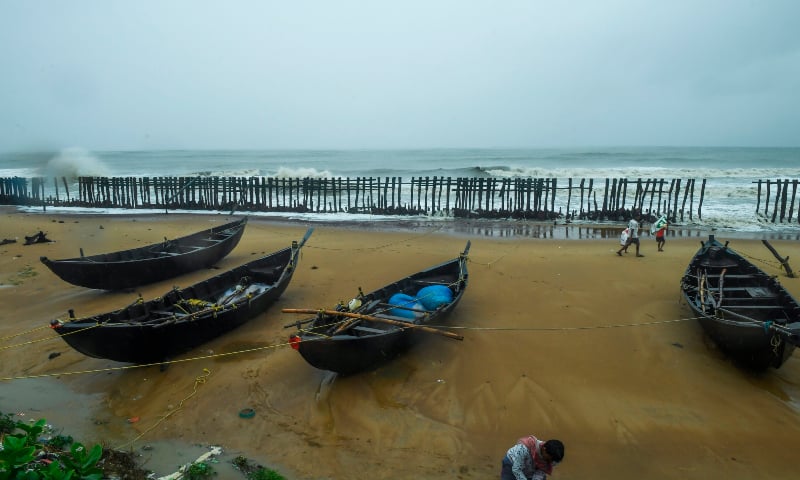Several million people were taking shelter and praying for the best on Wednesday as the Bay of Bengal’s fiercest cyclone in decades roared towards Bangladesh and eastern India, with forecasts of a potentially devastating and deadly storm surge.
Authorities have scrambled to evacuate low lying areas in the path of Amphan, which is only the second “super cyclone” to form in the northeastern Indian Ocean since records began.
But their efforts have been hampered by the need to follow strict precautions to prevent the spread of the coronavirus pandemic, with infection numbers still soaring in both countries.
“At least 50 people took shelter in my concrete-built house. They came last evening. We gave them food,” Abdur Rahim, a Bangladeshi shrimp farmer on the edge of the Sundarbans mangrove forest told AFP.
“There is panic. The women are worried […] A few months ago Cyclone Bulbul smashed our village, destroying at least 100 homes. We hope Allah will save us this time.”
Early Wednesday the vast weather system — visible from space — was 125 kilometres offshore with gusts up to 200 kilometres per hour (125 mph), the equivalent of a category three hurricane, the Indian Meteorological Department said.
It was expected to ease slightly but still pack a ferocious punch when it crosses the coasts of West Bengal state and neighbouring Bangladesh on Wednesday “afternoon to evening” with gusts up to 185 kph.
Bangladeshi forecasters said it would hit around 6pm (local time), with a potential storm surge up to five metres.
The storm could “cause large-scale and extensive damage”, said the head of India’s weather office Mrutyunjay Mohapatra, with a surge of several metres.
Storm surges can force a wall of water to cascade several kilometres inland, and are often the biggest killers in any cyclone, typhoon or hurricane.
Sanjib Banerjee from West Bengal weather office said that parts of Kolkata could see “severe damage”. Early on Wednesday the sky there was ominously grey. At the coast, it was raining and the sea rough.
“We have mobilised more than 20,000 policemen, emergency workers and volunteers, boats and buses to evacuate around 300,000 people from coastal villages,” state premier Mamata Banerjee said.
“It’s a very difficult task when the state is combating the coronavirus pandemic,” she said.
Regular victims
Bangladesh’s low-lying coast, home to 30 million people, and India’s east are regularly battered by cyclones that have claimed the lives of hundreds of thousands of people in recent decades.
The eastern Indian state of Odisha was hit by a super cyclone that left nearly 10,000 dead in 1999, eight years after a typhoon, tornadoes and flooding killed 139,000 in Bangladesh. In 1970 Cyclone Bhola killed half a million.
While the storms’ frequency and intensity have increased — a phenomenon blamed partly on climate change — deaths have fallen thanks to faster evacuations, better technology and more shelters.
But Bangladesh authorities still fear that Amphan will be the most powerful storm front since Cyclone Sidr devastated the country in 2007, killing about 3,500 people and causing billions of dollars in damage.
The country has been feverishly working to bring 2.2 million people to safety, while West Bengal was relocating 300,000 others.
The Catholic Relief Services (CRS) aid group said people faced “an impossible choice” of braving the cyclone by staying put, or risking coronavirus infection in a shelter.
Authorities in both countries said that they were using extra shelter space to reduce crowding, while also making face masks compulsory and providing extra soap and sanitiser.
“We are also keeping separate isolation rooms in the shelters for any infected patients,” Bangladesh’s junior disaster management minister Enamur Rahman told AFP.
Rohingya refugees
Although outside the predicted direct path of the storm, there are fears for the safety of almost a million Rohingya refugees from Myanmar in southeastern Bangladesh — most living in vast camps and housed in flimsy and makeshift shacks.
The first coronavirus cases were reported there last week, and by Tuesday there were six confirmed infections.
The United Nations said emergency items such as food, tarpaulins and water purification tablets had been stockpiled, while authorities said the refugees would be moved to sturdier buildings like schools.
“Heavy rains, flooding (and) the destruction of homes and farmland, will increase the likelihood of the virus spreading, particularly in densely populated areas like the refugee camps in Cox’s Bazar,” ActionAid said.
“It will also undoubtedly increase the number of lives and livelihoods already lost to this pandemic.”

